The Kiev rangefinder
camera is a near carbon copy of the pre-war German Contax II camera. The
Soviets seized The Zeiss Ikon plants in Dresden and Jena totally intact
at the end of the war. Some of the Zeiss manufacturing equipment was shipped
to the Soviet Union -- some was later returned to East Germany. Production
of the Kiev II began in 1947. Many of the early Kievs contained a lot
of "liberated" German parts. The Kiev 35mm cameras were considered
the "high end" of Soviet rangefinder camera production, commanding
higher prices than the FED and Zorki Leica copies. They seemed to have
gone to officials and professional journalists. Given their reputation
it is somewhat surprising that there are so many used cameras available
today--and in many cases the later Kiev models are cheaper that the Leica
copies that were made for the masses. Kiev II production ended in 1955.
The Kiev II, like the Contax II was not synchronized for flash, although many were later modified. The Kiev III was a copy of the Contax III, easily recognizable because of the light meter perched on top of the body. In my opinion the light meter model had more ugly than it could possibly use (very few of the meters work today).
The Kiev 4 in metered and non metered ( 4A) models--was made from the 1950s until the 1980s. The last variant, the Kiev 4AM, had such modern refinements as a hot shoe and real rewind crank. The construction quality of the 4AM wasn't as good as the earlier cameras, however. I read somewhere that toward the end of Kiev production in the early 1980s, the quality was so poor many of the cameras were hauled directly from the factory to the dump!
There was a short-lived Kiev 5 model that was only produced from 1973 to 1975 and was incompatible with earlier Kiev/Contax lenses. They are rare today. There also is a Contax/Kiev "no name" model that was made with Russian parts in German plants in 1963-64, probably for foreign consumption and has a Zeiss-manufactured Sonnar lens. There is no name on the face plate and the cameras are considered as good as the German Contax. They also are very rare and command high prices.
The Kiev 4A uses the f2 Jupiter 8 lens and a camera in good working order can produce excellent photographs even today. The Kiev shutter, featuring a vertical metal blind, is more complicated to repair than Leica-type shutters.
Contax
II w/Sonnar f1.5 lens
This is the father of the Kiev -- the German Zeiss Ikon Contax II. Contax
II production began in 1936. This camera was produced in 1938. According
to Peter Hennig, a well-known writer and member of the Zeiss Historica
Society, the f1.5 Sonnar on this camera is relatively rare. Hennig said:
It is quite likely that the camera was fitted with this lens from the very beginning. This Sonnar is in a batch of 3000 Sonnar 1,5/5cm lenses, in the number serial 2 551 801 - 2 554 800, that left Zeiss on the 03.06.1939. A small quantity of this serial of lenses where T-coated. This was the first serial coated lenses on the civilian market.
The prewar Contax did not come from the factory with a connection for a flash. Some had that feature added later.
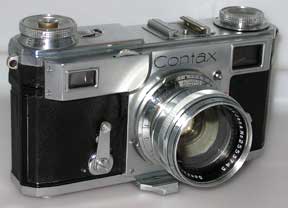
One of the advantages of the prewar Contax shutter was that because of its design the negative was always evenly exposed. On Leica shutters one curtain might move more slowly than the other causing uneven exposure. Postwar Contax shutters did not provide that uniformity.
Contax
IIa w/Opton Sonnar f1.5 lens
In March, 1950
Zeiss-Ikon introduced the Contax IIa in the U.S. The IIa was much improved
over the pre-war Contax but still had some family resemblance. These early
"black dial" bodies were supplied with coated lenses produced by the Zeiss
lense plant in Jena. A metered version called the IIIa was announced as
available in the U.S. in June 1951. These early models have a mechanical
flash sync that coupled to an accessory synchroniser which screwed into
the flash socket. These cords are very difficult to find. The mechanical
sync was discontinued in 1953 to be replaced by a fully synced Contax
"colored dial" version.
Lenses made in West Germany carried the Opton name while East German lenses carry the Jena designation.
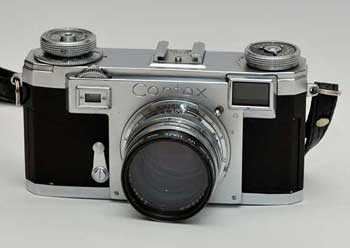
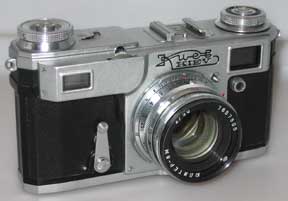
The Kiev 4a went into production in 1958. It differed from the Kiev II in several respects. There was no folding foot on the camera base and the accessory shoe was no longer engraved in English. The quality of construction of the Kiev 4A seemed to drop over the years. This 1971 model still had a decent chrome finish (although not as good as the ones in the 1950s and 1960s) It still was covered with leather. The self-timer lever was all chrome. There is a leather-covered bump at the top left of the lens mount (as you face the front of the camera), beneath the protruding rangefinder housing. The top shutter speed is shown as 1/1250 sec. The self timer lever is metal, without the leather accents
The Kievs have a flash connector but the electric contacts stay closed after the shutter fires. If you do not advance the film immediately, the flash will continur to fire.
The 1979 Kiev 4A isn't as well finished as the 1971 model. It is covered with vulcanite rather than leather and the lens mount has been enlarged to cover the area where there was a bump on the '71 camera. The self-timer lever is shorter and has plastic inserts. The shutter speed dial goes to 1/1000 sec. rather than 1/1250. The shutter hasn't been changed--the company was just acknowledging that the 1/1250 sec. speed on the old models wasn't accurate.
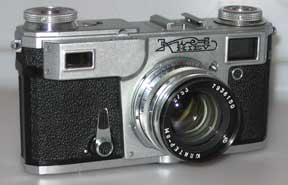
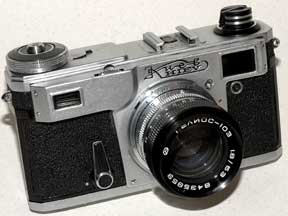
Kiev
4AM 1982
The last Kiev model boasted a rewind crank and a hot shoe on top. The
4AMs around 1980 were so poorly made some were hauled directly from the
factory to the dump. About 1982 an effort was made to improve the quality.
The last Kiev 4s were made in 1986--pretty remarkable for a camera design
from the mid 1930s!
Like the other 4As from the late 1970s the finish on the 4AMs was not as good as on the Kiev IIs and early 4As. But the 4AM can be a great shooter if you get one that is mechanically sound, they are very cheap and the normal lens is excellent.